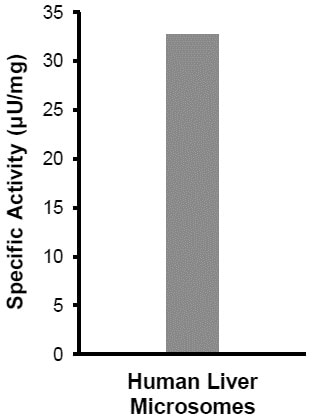CYP2C19 Activity Assay Kit (Fluorometric) (ab211072)
Key features and details
- Assay type: Enzyme activity (quantitative)
- Detection method: Fluorescent
- Platform: Microplate reader
- Sample type: Cell Lysate, Microsomes, Tissue Lysate
Overview
-
Product name
CYP2C19 Activity Assay Kit (Fluorometric)
See all CYP2C19 kits -
Detection method
Fluorescent -
Sample type
Cell Lysate, Microsomes, Tissue Lysate -
Assay type
Enzyme activity (quantitative) -
Species reactivity
Reacts with: Mammals, Other species -
Product overview
CYP2C19 Activity Assay Kit (Fluorometric) (ab211072) allows rapid measurement of native or recombinant cytochrome p450 2C19 (CYP2C19) activity in biological samples such as liver microsomes. The assay is based on the conversion of a non-fluorescent CYP2C19 substrate into a highly fluorescent metabolite, which can be detected in the visible range (Ex/Em = 406/468 nm), ensuring a high signal-to-background ratio with little interference by autofluorescence. A highly selective CYP2C19 inhibitor is provided for determination of CYP2C19 specific activity in heterogeneous biological samples, where other CYP isozymes may contribute to substrate metabolism.
The kit contains enough reagents to perform 50 sets of paired reactions (in presence / absence of inhibitor).
-
Notes
Cytochrome P4502C19 (CYP2C19, EC 1.14.14.1) is a member of the cytochrome 450 monooxidase (CYP) family of microsomal xenobiotic metabolism enzymes. CYPs are membrane-bound hemeproteins responsible for Phase I biotransformation reactions, in which lipophilic drugs and other xenobiotic compounds are converted to more hydrophilic products to facilitate excretion for the body. Isoforms of CYP2C subfamily are responsible for metabolism of nearly 20% of all small molecule drugs used by humans.
CYP2C19 is primarily expressed in liver and intestinal tissue and catalyzes oxidation of neutral or weakly basic lipophilic molecules with 2 – 3 hydrogen bond donor/acceptor sites. Polymorphisms in the human CYP2C19 gene have been implicated in clinical drug/drug interactions involving wide-prescribed drugs such as anticonvulsants or antiplatelet agents.
-
Platform
Microplate reader
Properties
-
Storage instructions
Store at -20°C. Please refer to protocols. -
Components 100 tests β-NADP+ Stock 100X (2 mg) 1 vial 3-CHC Standard (2 mg) 1 vial CYP2C19 Assay Buffer 1 x 100ml CYP2C19 Inhibitor ((+)-N-3-benzylnirvanol) (2 mg) 1 vial CYP2C19 Substrate (2 mg) 1 vial NADPH Generating System 100X (5 mg) 1 vial Recombinant Human CYP2C19 (10 mg) 1 vial -
Research areas
-
Relevance
Responsible for the metabolism of a number of therapeutic agents such as the anticonvulsant drug S-mephenytoin, omeprazole, proguanil, certain barbiturates, diazepam, propranolol, citalopram and imipramine. -
Cellular localization
Endoplasmic reticulum membrane; Peripheral membrane protein. Microsome membrane; Peripheral membrane protein. -
Alternative names
- (R)-limonene 6-monooxygenase
- (S)-limonene 6-monooxygenase
- (S)-limonene 7-monooxygenase
see all
Images
-
Typical 3-CHC standard calibration curve. One mol of 3-CHC corresponds to the metabolism of one mol of CYP2C19 substrate.
-
Reaction kinetics of fluorogenic substrate metabolism in human liver microsomes (0.25 mg/mL) at 37°C in the presence and absence of the selective CYP2C19 inhibitor (+)-N-3-benzylnirvanol. Solvent control: assay buffer + 0.5% acetonitrile.
-
Specific activity of CYP2C19 in pooled human liver microsome sample (0.25 mg/mL).












